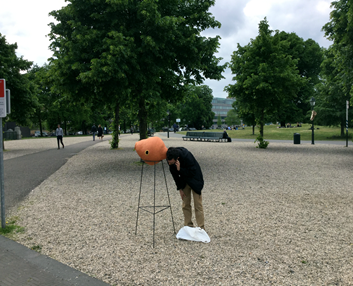A Categorical Retreat
As a sound artist and composer I have a great interest in folk music from around the world. One of the directions this interest manifests is the udu. The udu is a Nigerian instrument native to the Igbo people. It is a clay pot instrument with two holes that can be played by hitting one of the holes. The pressure from the blow is transformed into a tuned percussive sound.
Playing the udu with your hand is not the only way it can produce sound. When you put your ear against one of the holes, the udu acts as a filter for its surroundings. The sounds of the environment are altered through the udu. Voices become harmonic mumbles, and the traffic sounds like an ever changing ringing drone. When being placed in The Hague as an intervention, curious people began to listen to the udus. They described the experience as a mirror of public space and started talking about resemblances between what they heard and experiences they had in the past. One man stated that the sound could only be made by God, and that they were proof of His existence.
How can one hear the sonic qualities of a spoken sentence in a language one knows? It is hard to go beyond the embedded content of objects. Transformation and altering are powerful tools to make constructs and processes visible. I want to propose a retreat from categories, a sonic mirror trough transformation. The udu is placed on a pedestal. This resembles the way ceramic objects are presented in our culture. However, the udu still remains an instrument. It becomes a tool that transforms the surrounding sounds. The usual category index of actuator, instrument, and perceiver are altered. The environment becomes the input of the instrument. No need to be quiet. More input from the surrounding makes for a richer sound pallet.


